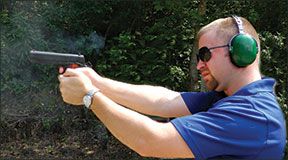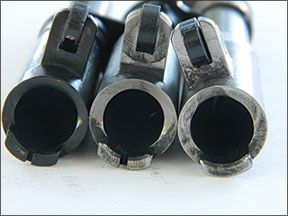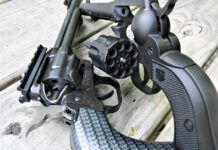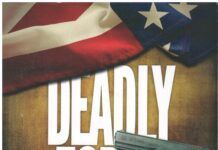There are those who feel that the 1911 handgun is the finest defense pistol available. But this isnt the only reason for the 1911s popularity. The 1911 also caters to those with a sense of history and emotional attachment. This is why the World War I and World War II reproductions and GI guns are so popular. But when it comes to a deadly serious defense gun, only the facts and performance matter. The Commander-size pistol is wisely shorter and lighter than the long and heavy Government Model.

The Commander is defined by a 4.25-inch barrel and a barrel bushing that is shorter than the Government Model. The pistol may be steel frame or aluminum frame. The Commander is easier to carry and faster from leather. By the same token, the Commander is easier to shoot well than the 3- or 3.5-inch-barrel 1911 handguns. The Commander features the full-length grip frame rather than the shortened Officers Model grip frame. All told, the Commander gives up little to the Government Model in terms of practical performance. All Commanders are not created equal, however.
We realized some months ago that we needed to take a closer look at this 45 ACP pistol category because of the Commanders unique features. We had tested only a few of this type, by name: the Michiguns 45 Commander Custom (May 2009), Colt Lightweight Commander 04860 XSE 45 ACP (October 2003, January 2002), and the Colt M1991A1 Commander (October 1993). So in the November issue, we tested three Commander-size 45s: a Ruger SR1911CMD No. 6702, $829 (Grade B); a SIG Carry Stainless 1911CA-45-SSS, $1142 (Grade A- and a Best Buy); and a Kimber Pro Custom Defense Package (CDP) II, $1331 (Grade A), the only aluminum-frame pistol in that match up. Also, the CDP II had a 4-inch barrel that didnt give up much in velocity and was actually the most accurate pistol tested in November. We also liked the Kimbers ambidextrous safety.
This time around, we were looking for a reliable personal defense Commander for less than the Rugers price. The first of our test handguns was a used Colt Commander Series 80 No. 04091U 45 ACP, $974 NIB, and $800 as tested. Gun Tests had not evaluated a stainless-steel-frame Colt Commander prior to this. We also chose a Para USA Expert Commander No. 96748 45 ACP, $799, and a new Shooters Arms Manufacturing (S.A.M.) Commodore 45 ACP, available from Century International Arms as No. HG1009-N. Our S.A.M. cost $429.

We tested with three different cartridge brands, two of which had self-defense-style hollowpoints. The first was Speers 230-grain Gold Dot Short Barrel load, which developed 334 foot-pounds, 345 foot-pounds, and 339 foot-pounds of muzzle energy out of the Colt, S.A.M. Commodore, and Expert respectively. Thats slightly better overall than a 230-grain Fiocchi load shot out of 5-inch 1911s in the October 2012 issue, which averaged 828 foot-pounds of muzzle energy. Average group sizes were on par with the full-size 1911s in October 2012 as well, coming in at 2.5, 3.3, and 2.25 inches for the Colt, Commodore, and Expert respectively.
With Barnes 185-grain TAC +Ps, the Para Expert created the most energy (339 foot-pounds) and the best accuracy (2.3-inch average groups at 25 yards), bettering the Colt (331 foot-pounds, 2.5-inch average groups), and the Commodore (323 foot-pounds, 3.1-inch average groups). The order of results was a little different for the Fiocchi 230-grain FMJs, with the S.A.M. delivering the best energy numbers but the worst accuracy (329 foot-pounds, 3.2-inch average groups), followed by the Para pistol (321 foot-pounds, 2.6-inch average groups) and the Colt (310 foot-pounds, 2.7-inch average groups).
Also, our shooters drew all three pistols for a dozen repetitions to check for sharp edges and snags. We used a Jeremiah IWB holster (JeremiahHolsters.com) with alligator trim, a tension screw, and dual belt loops. It proved well made and efficient.
Shorter than the Government Model and fast into action, the Commander carries light on the hip but speaks with real authority. Heres what we heard from these Commanders at the range:
Para USA Expert Commander No. 96748 45 ACP, $799
The Para may be an Experts gun, but all of the raters handled it well. The original Expert line was the full-size Para Ordnance GI Expert. The GI Expert is intended to compete in the GI market and does a good job in this niche. The Para USA Expert Commander is a happy blend of good features and price-saving features that come off well.
The price-saving features included a matte finish rather than a brushed blued finish or stainless construction. There were no forward cocking serrations, and the front strap was not checkered. There was no ambidextrous safety on the Para (or the other two pistols). The sights were not Novak sights, and there was no tritium insert. But the Expert Commander featured a well-done beavertail grip safety, a slightly elongated slide-lock safety, and a skeletonized trigger. Trigger compression was smooth and crisp at 4.75 pounds. The pistol featured a fiber-optic-insert front sight that all raters felt was an advantage in rapid combat-type firing. The front sight was dovetailed in place, unusual for a pistol in this price range.
The pistol never failed to feed, chamber, fire, and eject over 200 rounds fired in combat shooting. Lead SWC handloads, +P, and JHP loads fed perfectly. The Para was the most accurate pistol tested. However, when testing a defensive pistol, absolute accuracy isnt the most important part of the equation, only a part. The pistol must also be fast and smooth in handling.
Our team found that the Expert Commander cleared leather quickly and there were no sharp edges to abrade the hand. The Expert Commander is advertised at certain outlets with wooden grips and others with the black grips. Ours had checkered wooden grips that were well done with respectable checkering.
The sights were good defensive handgun sights. The rear sight of the Expert Commander and the Colt were identical. The rear sight was taller than a GI sight. We like this sight for general use. It isnt a Novak sight, but then this isnt a $1000 gun. The pistol was supplied with two excellent eight-round magazines whose base pads may affect concealment. The Para magazine springs were very strong. It was difficult to convince the slide to release off an empty magazine, but then there is no need. This is one reason the pistol always feeds reliably. Though the Colt never failed to feed and eject, there were a number of times when it failed to lock back on the last round with light handloads. The Para Ordnances strong magazine spring gives it an extra edge.
The Expert Commander was the only lightweight-frame pistol tested. The others were steel-frame pistols with a 7-ounce weight advantage in firing heavy loads, and a 7-ounce disadvantage in carry. When firing, the Expert Commander recoil was not noticeably heavier than the other handguns, at least in firing standard loads and a few magazines of +P loads. A combination of a well-designed upswept beavertail safety that spreads recoil about on the palm and a proper recoil spring mean much in a lightweight frame 45 ACP. Make no mistake, if you engage in a rigorous practice program, the increased recoil will began to tell on the wrists after a few hundred rounds, but as far as accuracy and control in range practice, the weight penalty isnt difficult to adjust to.
Our Team Said: The pistol never failed to function, and the Expert Commander was the most accurate handgun tested. The Para Ordnance has superior sights compared to the Colt, a better trigger action by a slight margin, and a superior beavertail safety and slide lock safety, in our opinion. It was as reliable as the Colt. The Para pistol also features a superior scalloped ejection port. The only real edge the Colt had was that its magazines were flush fit.
The drawback to this pistol was its finish. Matte-finished guns, in our experience, wear more quickly than bright blue, and stainless is superior to both. But the pistol is low reflective, if that matters to you. During the test we picked up a couple of scratches on the finish. This isnt a concern in personal defense, as pistols that are used in every day carry will show wear. In our opinion, the Para USA was the best performer and we think it is a Best Buy.
Colt Commander Series 80No. 04091U 45 ACP, $974 NIB;$800 as tested
This was a used Colt purchased with the original box and two magazines. The rubber grips had been replaced with checkered wood grips, and the synthetic mainspring housing was replaced with a metal housing. The finish had a few scratches around the front of and on top of the slide. Stainless construction is a plus in a service pistol. We are not certain it would be worth the extra $270 or so over the Para Ordnance for a new gun, but in a used gun at this price, stainless is nice to have. Functionally, the pistol was a good buy.
Though marked Commander, this was the steel-frame Commander. This may lead to confusion because the Commander was once an aluminum-frame-only gun. The steel-frame guns were marked Combat Commander. Today, the Commander is the steel-frame gun and the LW frame is the Lightweight Commander.
The pistol exhibited good slide-to-frame fit and good balance. The safety wasnt extended, and the beavertail was a slight improvement over the GI pistols. The sights were better than those on GI guns. They were usable, but the front sight was staked rather than dovetailed. This is okay, and we havent seen a Colt lose its front sight in some years, but we prefer a dovetailed front sight when we can get it.
The pistol was supplied with two flush-fit magazines. Flush fit is good for concealed carry. The magazines were well made and locked properly. The Colt featured a 5.2-pound smooth trigger compression.
Out of the holster, the Colt handled well. The pistol was well balanced and fast, but the Paras upswept grip safety seems to make the draw fractionally faster for those who practice. The Colt was fast on target and offered good hit probability. In slow-fire runs off the bench, the Colt Commander proved accurate enough for any reasonable self-defense chore.
Our Team Said: This was a good, solid handgun from our oldest maker of 1911 handguns. Any wish for superior sights or features would be answered by Colts elevated XSE design.
Shooters Arms ManufacturingS.A.M. Commodore, CIANo. HG1009-N 45 ACP, $429
This Philippine-made pistol is called the Commodore, and we all know a Navy Commodore outranks a Commander. When first examined, this pistol showed the greatest promise among the raters. Without exception, all remarked on the good fit and finish for the price. The slide-to-frame fit was tight, and the slide rolled over the locking lugs with a good feel. The barrel bushing was tight, but not too tight to be removed with the fingers. The slide featured an ejection port scalloped out in a manner superior to the Colt but equal to the Para. The rear sight was the best design of the three pistols, in our view. This rear sight was thicker than the others, and though thats a practical advantage not evident at the range, the sight looked right and the design is respectable. The front sight was dovetailed in, superior to the staked-in Colt, in our view. The pistol also featured a solid rib down the center of the slide in classic Gold Cup fashion. The grips were rubber, just fine for an inexpensive pistol. The Colt, at $974 for a new gun, is also supplied with rubber grips. Trigger compression was smooth enough, but it was the heaviest of the three pistols at 6.25 pounds. The pistol was supplied in a compact plastic box with a single ACT MAG magazine.
The pistol exhibited quite a few tool marks. When we field-stripped the S.A.M., the recoil spring simply fell off of the recoil spring guide. It was not a press fit. This did not impede function, but doesnt seem ideal.
The Commodore featured a well- designed beavertail grip safety and extended slide lock. Each worked well. The safety had a good indent. A feature we did not care for was the large paddle-type slide lock. Past experience indicates that these slide-lock-safety designs are prone to problems. Whether the extra weight builds momentum or the support hand contacts the slide lock and forces it into the slide, these heavy slide locks tend to cause tie-ups in the 1911.
The slide lock indent is in the same position as the other 1911s, but the other slot is not. To sum up, the initial opinion after the pistol was field stripped and examined, there were many positive comments concerning the pistol. When the firing test came, we were disappointed.
During firing strings, the pistol continually locked open during the initial test with 230-grain ball ammunition. Despite attempting to shift the grip, the problem was traced to the support hold contacting the oversize slide lock. Adopting a very low support hand hold helped, but only by firing with one hand was the problem alleviated. That isnt acceptable. The second problem was worse. The pistol would not feed any of the hollowpoint ammunition we brought to the range. Not the loads chosen for testing, not a few XTP loads in the range bag, and not even the Winchester Silvertip, a bullet with a nice rounded ogive. There was no use to waste more money and ammunition by checking the piece with other types. This is a new pistol and should feed JHP ammunition.
Even when it ran, there was the problem with the slide lock. Later, we took a Wilson Combat 1911 Auto Bullet Proof Slide Stop (Brownells No. 965-414-000WB) out of the parts bin and retested the pistol. This time we were able to get in some practice with the Commodore. Handling and accuracy were fine. But the pistol continued to operate only with hardball ammunition.
Our Team Said: There were several strikes against the S.A.M. Commodore. The Commodore was not supplied with a spare magazine, which is okay in an inexpensive pistol, but the other handguns and most 1911 pistols are supplied with at least one spare magazine. That adds some money. Just picking the first one on the list at Brownells, a Metalform 8-round unit, 620-000-017WB, costs $40. The guide-rod fit to the recoil spring was not welcome, but it was not a deal breaker. The problem with the slide lock was fixed, but at the cost of $58. Adding this cost plus that of a new magazine for a spare moves the Commodore closer to the price of the Para, and the pistol still doesnt work correctly. We still have the problem of failures to feed with JHP ammunition. The barrel ramp of the Commodore needed much work. The only reason the pistol did not receive an F was because it wasnt actually unsafe to fire. The pistol had good features and seems well made in many areas, but from our perspective, attention to detail is lacking. We would not buy this gun in its current state.
Written and photographed by R.K. Campbell, using evaluations from Gun Tests team testers. GT




























